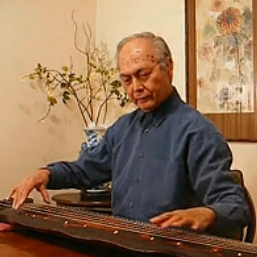Lu Peiyuan
Organized by 棠舟 on 2022-04-06

Lv Peiyuan, a native of Wuxian County, Jiangsu Province, studied ancient tunes with Mr. Xiao Yunge and Mr. Xia Baochen in Shanghai in his early years. After he came to Hong Kong in 1951, he also studied Guqin with Mr. Wu Zonghan. And enrich professional Chinese music performance, film soundtrack recording, organization of orchestras and Chinese musical instrument education.
In addition to being good at playing pipa and guqin, Lu is also proficient in a variety of silk and bamboo instruments in the traditional Jiangnan silk and bamboo skills, and has also integrated new fingerings of pipa for more than ten years, emphasizing both rigidity and softness. He can be said to be a pioneer in the Chinese music industry in Hong Kong. He established the Chinese Orchestra in 1961, and has cultivated many talents for more than 20 years. In 1972, he assembled many of the most active Chinese orchestras in Hong Kong. Hosted a Chinese music performance for the Hong Kong Urban Council, which was a major orchestra event before the establishment of the Hong Kong Chinese Orchestra. Lui spared no effort in the education of Chinese instrumental music in Hong Kong. He was the earliest pipa instructor in the Department of Music at CUHK and one of the initiators of the Chinese Music Competition at the Hong Kong Inter-School Music Festival. The Hong Kong Chinese music industry has written a rich page.
Lui is gentle and elegant, and is the most bookish pipa player of the Hong Kong Orchestra. After immigrating to the United States in 1973, he is still committed to promoting Chinese music. He has taught in many music schools in the United States, and often tours many cities in the United States and Canada to perform, wherever he goes. , rave reviews.
Similar artist
LAN Weiwei, born in May 1980, studied at the Affiliated Middle School of Sichuan Conservatory of Music from 1992 to 1998. She has long been the chief of the strumming section of the Youth Chinese Orchestra of the Central Conservatory of Music.
read >>
Yu Yuanchun, female, teacher of the Central Conservatory of Music, the first doctor of pipa from the Central Conservatory of Music, director of the Chinese Ethnic Orchestral Society, pipa player of the National Orchestra of China, UNESCO special artist.
read >>
Wu Bing, a pipa player, a Chinese living in France, the first recipient of the "Angel of Chinese Culture" who spread Chinese culture in France.
read >>
Graduated from Sichuan Conservatory of Music majoring in pipa, he is more beautiful than Qin Huai, and the master of Pipa Up at station B: Jumo Peanut Butter. Is a new generation of traditional Chinese music performers.
read >>
Zhang Yadi is a young Chinese pipa performer, a pipa teacher at Tianjin Conservatory of Music, a master’s degree from the Central Conservatory of Music, and the first BOB top-notch innovative talent of the Central Conservatory of Music.
read >>
Involving musical instruments
Pipa (pinyin: pí pa), the first plucked instrument, is a traditional plucked instrument in East Asia, a plucked stringed musical instrument. Made of wood or bamboo, the speaker is half-pear-shaped and has four strings on the top. It was originally made of silk thread, but now it is mostly made of steel wire, steel rope and nylon.
Guqin (pinyin: Gǔ Qín) is a traditional Chinese musical instrument with a history of at least 3,500 years. Guqin is also known as Yaoqin, Yuqin and Seven-stringed Qin. The guqin has 13 emblems that mark the rhythm, and is also a ritual and musical instrument. It belongs to the silk in the octave. Guqin has a wide range, deep timbre and long aftertone.
Involved portfolio
Involved news
Organized by 岚玖 on 2024-02-23
"Sunset Xiao Gu", also known as "Xunyang Night Moon" or "Spring River Flower Moon Night", is a highly representative classic of ancient Chinese pipa music.
read >>
Organized by ky on 2024-02-20
Pipeggio "Flying Flowers" is a very poetic and pictorial masterpiece in traditional Chinese music. With its fresh and elegant melody, it shows the exquisite description and unique feeling of the ancient literati on the beauty of nature.
read >>
Organized by 年糕 on 2024-02-20
The Piarpeggio "Zhaojun Out" is a masterpiece of historical significance and dramatic tension in traditional Chinese music. It narrates the historical event of Wang Zhaojun, one of the four beautiful women in ancient China, marrying Xiongnu and promoting peace between Han and Hungary with rich musical language.
read >>
Organized by 爱在西元 on 2024-02-20
The pipeggio "Yueergao" is one of the most popular songs in Chinese classical music. It is loved by many music fans for its melodious and profound artistic conception. This song originated from the Pipa song of the Ming and Qing dynasties. Through the unique musical language, it depicts a picture of peace and tranquility under the bright moonlight.
read >>
Organized by 薄暮 on 2024-02-20
The pipa solo "Snow in the Spring" is a shining pearl in the treasure house of Chinese national music, and is a classic pipa masterpiece that has been passed down through the ages and enjoys worldwide fame. Its name comes from Song Yu's "Ask the King of Chu" in the Warring States Period, which symbolizes the elegant and delicate artistic realm, profound meaning and beautiful melody, and has always been regarded as the best pipa art of "Yangchun Snow" style.
read >>

 渝公网安备 50010702504639号
渝公网安备 50010702504639号